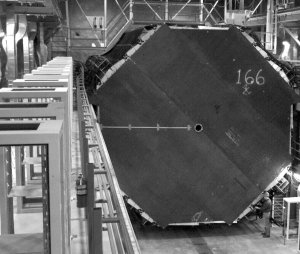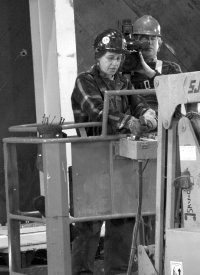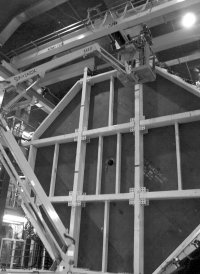 |
|
Upward Bound by Judy Jackson
The MINOS detector is currently under construction half a mile underground in a former iron mine in Soudan, Minnesota. To date, the project has installed about 180 layers of the 486 slices of steel and scintillator that will ultimately make up the detector.
When the MINOS collaboration begins experimental operations in 2004, it will detect neutrinos sent to Minnesota from the Fermilab Main Injector. Last week’s muon, however, was sent by Mother Nature, created by a cosmic ray in the atmosphere. Even in its unfinished state, the detector can “see” such particles generated by cosmic rays.
Why is the sighting of an upward-going muon so exciting? Because it means the MINOS detector works. It can distinguish the track of that all-important upward-going muon from the many thousands of tracks of muons going the other way—not upward through the earth, but downward from the sky. For every upward-moving track, the detector observes about 10,000 tracks of downward-moving muons. It is a great test of the pattern-recognition capabilities of the MINOS detector that it could pick out the needle of the upward-moving track from the haystack of downward-moving muons.
“Finding this upward-bound muon is a great tribute to all the people who have worked so hard to design and build the MINOS detector, and to write and debug the software that made the observation possible,” said MINOS spokesman Stan Wojcicki. “It is very gratifying to us to see it all come together.”
|
 On Tuesday, March 26, 2002, the MINOS detector saw its first upward-going muon.
On Tuesday, March 26, 2002, the MINOS detector saw its first upward-going muon.

 Since July 2001 when the first plane was installed, the MINOS collaboration has installed about 180 of the 486 far detector planes, meaning more than one third of the detector is installed and commissioned. A staff of 31 technicians is working on the installation, alongside MINOS physicists. There are usually about 12 physicists and students underground at Soudan each week. The MINOS collaboration expects to complete the first half of the detector in July, culminating in energizing the first of the two MINOS coils. The detector should be completed in the summer of 2003.
Since July 2001 when the first plane was installed, the MINOS collaboration has installed about 180 of the 486 far detector planes, meaning more than one third of the detector is installed and commissioned. A staff of 31 technicians is working on the installation, alongside MINOS physicists. There are usually about 12 physicists and students underground at Soudan each week. The MINOS collaboration expects to complete the first half of the detector in July, culminating in energizing the first of the two MINOS coils. The detector should be completed in the summer of 2003.